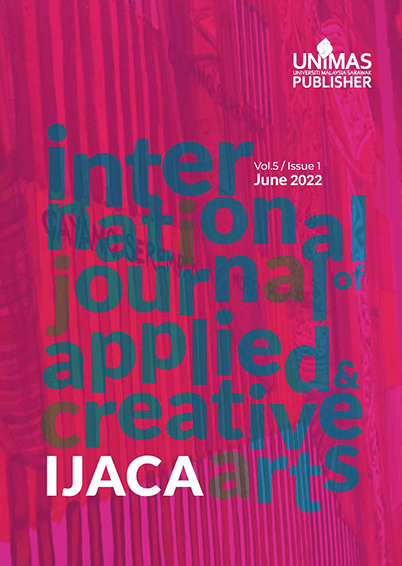EXPLORING FILM ARCHIVING IN MALAYSIA OR PRESERVATION AND CONSERVATION OF VISUAL HISTORY
DOI:
https://doi.org/10.33736/ijaca.4755.2022Keywords:
Malaysian films, Malayan films, digital era, FINAS, Arkib Negara, film preservation, film archive, film negative, film format, film gaugeAbstract
The Malaysian film industry has entered the digital industry when all production and national broadcasting companies shifted to digital equipment and facilities. This raises the issue on how to preserve local films from here on out regardless of the video recording method. While there are some government institutions tasked with digitising and preserving films (negatives) in Malaysia, little is known about the procedure, protocol, and priority of this development. Through in-depth interviews with key personnel from National Film Development Corporation Malaysia (FINAS) and Arkib Negara, the study investigates the fate of Malaysian films especially the ones produced using film format. Finding indicates that while there are intensive work conducted by both repository institutions to digitise archived films, priorities are given to film documentaries and government-related news coverage thus setting aside the jewels of Malaysian historical and classical feature films towards uncertain future.
References
Perumal, V. and Woods, P., (2007). The Need for Knowledge Management in the Malaysian Film Industry: A Case Study. Journal of Information & Knowledge Management, 06(03), pp.173-180.
https://doi.org/10.1142/S0219649207001731
Muthalib, H.A. (2013). Malaysian Cinema in a Bottle: A century (and a bit more) of wayang (pp. 37). Selangor, Malaysia: Merpati Jingga
Rosnan, H., Ismail, M.N., Daud, N.M., (2010). The globalization of film business and its effect on the Malaysian film industry, Business Strategy Series, Vol. 11 Issue: 5, pp.325-332, https://doi.org/10.1108/17515631011080731
https://doi.org/10.1108/17515631011080731
Wengstrom, J. (2013). Access to film heritage in the digital era - Challenges and opportunities. Journal of Film Preservation. Retrieved 15 February 2018 http://www.filminstitutet.se/globalassets/2.-fa-kunskap-om-film/digitalafilmarvet/diverse-bilder/access -to-film-heritage-in-the-digital-era.pdf
https://doi.org/10.18261/ISSN2000-8325-2013-01-09
Bastron, B. (2014). Preserving Film Preservation in the Digital Era. SLIS Student Research Journal, Retrieved 2 February 2018. http://scholarworks.sjsu.edu/cgi/viewcontent.cgi?article=1050&context=slissrj
https://doi.org/10.31979/2575-2499.020206
Aziz, J., Hashim, H. and Ibrahim, F., (2014). Malaysian Film Industry in Transformation: Challenges and Potential. Jurnal Komunikasi, Malaysian Journal of Communication, 30(1), pp.35-49.
https://doi.org/10.17576/JKMJC-2014-3001-03
Voges, C., (2016). On the Potential of Film as a Digital Storage Medium. Archiving Conference, 13(1), pp.91-94.
https://doi.org/10.2352/issn.2168-3204.2016.1.0.91
White, Y. (2017). Historical Poetics, Malaysian Cinema, and the Japanese Occupation. Kinema. Retrieved 2 February 2018, http://www.kinema.uwaterloo.ca/article.php?id=292&feature
Fliegel, K., Vítek, S., Páta, P., Novák, M., Myslík, J., Pecák, J. and Jícha, M., (2017). Set of Methodologies for Archive Film Digitization and Restoration with Examples of Their Application in ORWO Region. Archiving Conference, 14(1), pp.62-67.
https://doi.org/10.2352/issn.2168-3204.2017.1.0.62
Iordanova, D., (2020). Archiving and Film Restoration: The View from Asia. Frames Cinema Journal, (17).
Downloads
Published
How to Cite
Issue
Section
License
Copyright Transfer Statement for Journal
1) In signing this statement, the author(s) grant UNIMAS Publisher an exclusive license to publish their original research papers. The author(s) also grant UNIMAS Publisher permission to reproduce, recreate, translate, extract or summarize, and to distribute and display in any forms, formats, and media. The author(s) can reuse their papers in their future printed work without first requiring permission from UNIMAS Publisher, provided that the author(s) acknowledge and reference publication in the Journal.
2) For open access articles, the author(s) agree that their articles published under UNIMAS Publisher are distributed under the terms of the CC-BY-NC-SA (Creative Commons Attribution-Non Commercial-Share Alike 4.0 International License) which permits unrestricted use, distribution, and reproduction in any medium, for non-commercial purposes, provided the original work of the author(s) is properly cited.
3) For subscription articles, the author(s) agree that UNIMAS Publisher holds copyright, or an exclusive license to publish. Readers or users may view, download, print, and copy the content, for academic purposes, subject to the following conditions of use: (a) any reuse of materials is subject to permission from UNIMAS Publisher; (b) archived materials may only be used for academic research; (c) archived materials may not be used for commercial purposes, which include but not limited to monetary compensation by means of sale, resale, license, transfer of copyright, loan, etc.; and (d) archived materials may not be re-published in any part, either in print or online.
4) The author(s) is/are responsible to ensure his or her or their submitted work is original and does not infringe any existing copyright, trademark, patent, statutory right, or propriety right of others. Corresponding author(s) has (have) obtained permission from all co-authors prior to submission to the journal. Upon submission of the manuscript, the author(s) agree that no similar work has been or will be submitted or published elsewhere in any language. If submitted manuscript includes materials from others, the authors have obtained the permission from the copyright owners.
5) In signing this statement, the author(s) declare(s) that the researches in which they have conducted are in compliance with the current laws of the respective country and UNIMAS Journal Publication Ethics Policy. Any experimentation or research involving human or the use of animal samples must obtain approval from Human or Animal Ethics Committee in their respective institutions. The author(s) agree and understand that UNIMAS Publisher is not responsible for any compensational claims or failure caused by the author(s) in fulfilling the above-mentioned requirements. The author(s) must accept the responsibility for releasing their materials upon request by Chief Editor or UNIMAS Publisher.
6) The author(s) should have participated sufficiently in the work and ensured the appropriateness of the content of the article. The author(s) should also agree that he or she has no commercial attachments (e.g. patent or license arrangement, equity interest, consultancies, etc.) that might pose any conflict of interest with the submitted manuscript. The author(s) also agree to make any relevant materials and data available upon request by the editor or UNIMAS Publisher.

